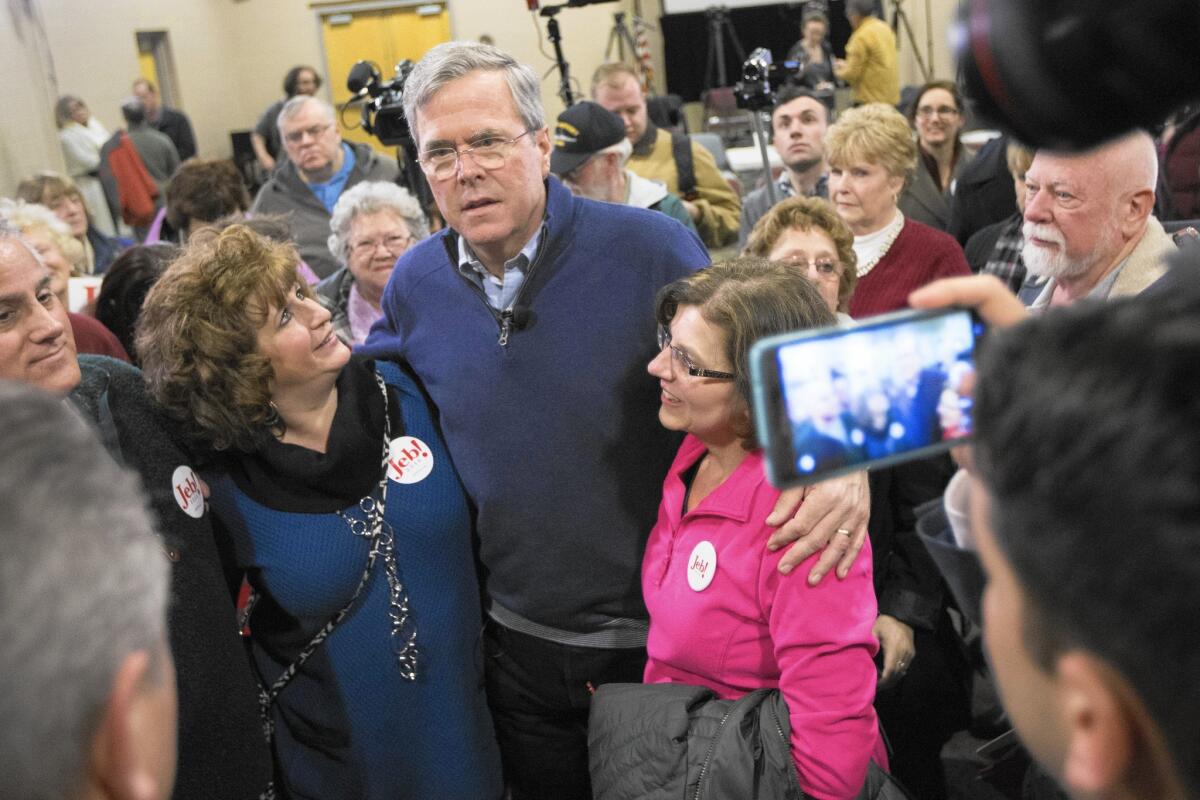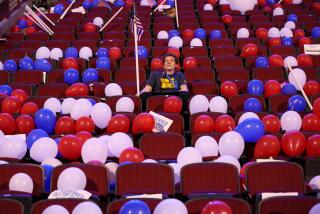Some Republican candidates spend big on ads, with little to show for it

Jeb Bush, center, at a campaign stop in Pelham, N.H., on Jan. 23. A super PAC has spent at least $60 million on ads for Bush, but he remains stuck at about 6% in polls.
Reporting from WASHINGTON — In a drumbeat that gets more insistent every week, viewers in early primary states have been subjected to a ceaseless cycle of ads for presidential candidates, courtesy of the big checks donors pour into super PACs and “dark money” groups.
What’s less clear: How much of it is getting through to voters?
In this strange primary season, there is little relationship between money spent on ads and poll numbers for candidates, at least on the Republican side. Former Florida Gov. Jeb Bush and Sen. Marco Rubio, the top two spenders, have spent about 10 times as much on ads as have the two polling leaders in Iowa, Donald Trump and Sen. Ted Cruz of Texas — who until recently bought far fewer ads than their rivals.
At this early stage of the race, the negative correlation between spending and support appears to be the result of the ever-evolving media landscape and a few other factors, some unique to 2016: a celebrity front-runner, a crowded field, questionable campaign strategies and voter burnout.
It’s a complete waste of money, and I think people are starting to figure that out.
— Barry Bennett, a Republican strategist
“It’s a complete waste of money, and I think people are starting to figure that out,” Barry Bennett, a Republican strategist, said of the expensive strategy of outside groups blanketing the airways with advertising at premium rates. Bennett, former campaign manager for Ben Carson, now is advising Trump.
Even at its best, television is a blunt tool for reaching the relatively small numbers of people who vote in small-state primaries. “The money spent per actual voter is huge,” said Joe Fuld, a Democratic campaign consultant. “It’s like trying to kill a fly with a sledgehammer.”
Some suggest that the problem isn’t the medium but the message; the ads aren’t working as well because they simply aren’t very good. No one has come out with a standout ad that generates its own buzz. And this year, ads that tout a candidate’s credentials or attack opponents with grainy footage aren’t getting through.
Some of the explanation also lies with which candidates were doing the advertising. Right to Rise, the super PAC supporting Bush, raised more than $100 million before the campaign got underway and paid for a bombardment of ads in an attempt to jump-start his sputtering candidacy. After at least $60 million in spending, Bush remains stuck at about 6% in polls.
“Guys like Jeb Bush are spending more than anybody and he has absolutely nothing to show for it,” said Justin Holmes, a politics professor at the University of Northern Iowa.
“If they don’t like what you’re selling, it won’t matter how much you try to sell it.”
Trump, Bush’s antagonist, meanwhile, didn’t advertise at all until recently. But he stormed to the top of the field and has stayed there while dominating news coverage and speaking directly to millions of followers on Facebook and with a Twitter feed full of insults, incendiary statements and promises to restore America’s swagger.
For Trump, riding a wave of television celebrity and media fascination, buying commercials would have been overkill. Trump has been mentioned about 195,000 times on news shows since he entered the race, according to an analysis by the Internet Archive — more than twice the coverage of Bush, the next most-mentioned GOP candidate.
Whenever someone on television mentioned a Republican candidate, 4 out of 10 times it was Trump.
“That’s swamping some of the ad spending,” Holmes said, explaining that Trump’s free media exposure was more valuable than others’ paid airtime.
For candidates without Trump’s news saturation, an increasingly fractured media landscape also is making it tougher for them to get their messages across.
“You have more media outlets today than you’ve ever had, and the audience is more and more splintered,” said Dominic Caristi, a professor of telecommunications at Ball State University. “It’s made anything less effective, whether we’re talking about an ad for Jeb Bush or an ad for Crest toothpaste.”
A recent Gallup survey found that fewer people than ever said that “watching television” was their favorite way to spend an evening. They might still be looking at some kind of screen, but the days of gathering around the set to watch a network show is on the wane, said Frank Newport, Gallup’s editor in chief.
“Now it’s dispersed,” Newport said. “With so many different kinds of screens and different ways of watching, it’s more complex to try to reach them.”
Millions of dollars’ worth of ad spending blended into the background cacophony, with more than a dozen voices in the Republican field struggling to differentiate themselves and to be heard at a time when many voters simply weren’t paying attention.
“Until January, most people in Iowa weren’t thinking about this,” said Travis Ridout, a politics professor at Washington State University and co-director of the Wesleyan Media Project, which tracks and studies campaign advertising.
“I think a lot of early advertising was wasted, in terms of trying to get votes on caucus day,” he said.
Burnout also might be a factor. With most states going safely Democrat or Republican, all the commercials are going to the relatively few places that are really competitive. For the last few cycles, that means the same viewers have been hammered in successive waves of political advertising.
“If you turn on your TV over the last few weeks, it’s one ad after another after another,” said Andrew Smith, a University of New Hampshire professor. “It just becomes wallpaper.”
Even with all the changes, most campaigns still regard broadcast as the most effective way to reach the most eyeballs. The volume of Republican presidential ads on the air for 2015 was up by nearly 45% over the same period four years ago — with outside groups, not campaigns, responsible for 81% of the spending, according to an analysis by the Wesleyan Media Project, using data by Kantar Media CMAG, a media tracking firm.
Kantar is predicting about $4.4 billion spent on television this election, with most of it going to local broadcast stations.
The ads that are doing better, in a time of deep dissatisfaction with anything that smells of old-school politicking, offer a promise of authenticity and an aspirational, idealistic message, according to Ace Metrix, a company that measures ad effectiveness. Mark Bryant, a vice president at Ace, said the firm had shown each ad released this year to focus groups of 500 voters from different parties and demographic groups.
Among Republicans, Cruz seems to be getting the most bang for his bucks; three of his ads were the highest-scoring among GOP voters, Bryant said.
But the ads getting the best overall response so far are from Sen. Bernie Sanders of Vermont, who is seeking the Democratic nomination. He has the four highest-scoring spots and seven of the top 10. “Fairness, equality, an economy that works well for all — these are themes that are resonating with Democrats and independents,” Bryant said. “They love his stuff.”
See more of our top stories on Facebook >>
MORE ON THE 2016 ELECTION
A week before the Iowa caucuses, Democrats seek an edge in front of voters at town hall
Julian Castro, campaigning for Hillary Clinton, embarks on a vice presidential test run in Iowa
Hillary Clinton and Bernie Sanders offer contrasting visions to liberal pocket of Iowa
More to Read
Get the L.A. Times Politics newsletter
Deeply reported insights into legislation, politics and policy from Sacramento, Washington and beyond. In your inbox three times per week.
You may occasionally receive promotional content from the Los Angeles Times.











